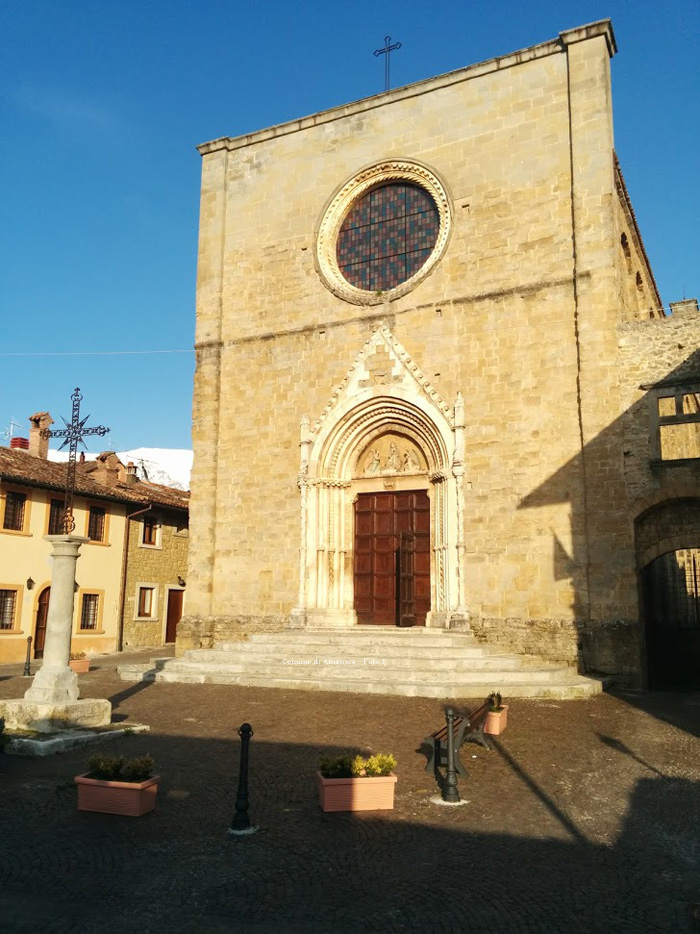Basilica di San Francesco
Alcuni documenti attestano già alla fine del XIII secolo l’esistenza della Chiesa di S. Francesco, pur avendo questa forme e caratteristiche trecentesche. Nella sua facciata a coronamento orizzontale si aprono l’oculo e lo stupendo portale gotico nella cui lunetta spicca un gruppo di statue in terracotta formato dalla Vergine in trono col Bambino affiancata da due angeli adoranti.
L’interno del duomo di Amatrice, ampio e di solenne austerità, è ad unica navata. La slanciata abside semipoligonale è a volta semistellare e ha le pareti corse da robusti cordoni alcuni dei quali posano su mensole configurate in mascheroni grotteschi. Essa è istoriata di affreschi dei secoli XIV e XV.
 Tra questi, è notevole quello rappresentante l’Albero di Jesse, opera di un artista marchigiano influenzato dai pittori riminesi. Altri affreschi di scuola marchigiana quattrocentesca sono dipinti sulle pareti della navata (Natività, Madonne col Bambino e Santi).
Tra questi, è notevole quello rappresentante l’Albero di Jesse, opera di un artista marchigiano influenzato dai pittori riminesi. Altri affreschi di scuola marchigiana quattrocentesca sono dipinti sulle pareti della navata (Natività, Madonne col Bambino e Santi).
Alla parete interna della facciata, è appoggiato un portico di pietra quattrocentesco, adorno di bassorilievi, e, su quella destra, domina il sontuoso altare seicentesco intagliato in legno dall’amatriciano Giovan Battista Gigli e messo poi a oro e azzurro. È dedicato alla Madonna di Filetta e venne eretto per custodire, entro un forziere, uno stupendo reliquario, in forma di tempietto gotico cesellato dall’orafo ascolano Pietro Vannini (1472). Dentro quest’ultimo è custodito il cammeo venerato dalla cittadinanza.
Sopra l’altare si estende un grande ed interessante affresco del tardo Trecento, rappresentante il Giudizio Universale. Notevoli anche il busto marmoreo cinquecentesco di Camillo Orsini e il pulpito barocco intagliato in legno.
Accanto alla chiesa, il restaurato chiostro dell’ex convento francescano. Nell’ex palazzo della pretura, già chiesa di S. Antonio, risalente alla fine degli anni ’20 dello scorso secolo, vi è oggi la sede del “Polo Agrolimentare” del Parco Nazionale Gran Sasso e Monti della Laga.
Al limite della piazza ove sorge la chiesa di S. Francesco, si trova la chiesa non più officiata di S. Fortunato (oggi abitazione privata) con singolare portale quattrocentesco.
There are documents attesting to the existence of the Church of St. Francis as far back as the end of the 1200s, despite the fact the church has forms characteristic of the 1300s. In its horizontally crowned facade, there is an oculo (round window) and a magnificent gothic portal with a lunette containing a group of terracotta statutes formed by the Enthroned Madonna and Child between two adoring angels.
The inside of the Amatrice Cathedral, which is spacious and solemnly austere, has a single nave. The slender semi-polygon apse with a semi-star shaped ceiling has solid cordons on the walls, some of which are supported by brackets in the form of grotesque gargoyles. The apse is decorated with frescoes from the 14th and 15th Centuries.
Among the frescoes, we find a notable work depicting the Tree of Jesse, by an artist from the Marche region influenced by painters from Rimini. Other frescoes from the 1400s Marche school are painted on the walls of the nave (Nativities, Madonnas with Child and Saints).
On the inside wall of the facade, there is a stone portico from the 1400s, decorated with bas-reliefs; the wall to the right is dominated by the magnificent 1600s altar carved in wood by the Amatrician Giovan Battista Gigli, and then finished with gold and blue. It is dedicated to the Madonna di Filetta, and was built to hold, inside a chest, a stupendous reliquary in the form of a small gothic temple carved by the Ascolan goldsmith Pietro Vannini (1472). This little temple holds a cameo venerated by the people of the city.
Above the altar we find a large and interesting fresco from the late 1300s, depicting the Last Judgment. The 16th Cent. marble bust of Camillo Orsini and the baroque pulpit carved in wood are also worthy of note.
Next to the church there is a restored cloister of the former Franciscan convent. In the former building of the pretura (praetorship) – which had previously been the church of St. Anthony – that dates back to the end of the 1920s, today we find the offices of the Agricultural and Food Center of the National Park of the Gran Sasso and Laga Mountains.
>At the edge of the piazza where the church of St. Francis stands, is the no-longer used church of S. Fortunato (now a private dwelling), with a unique 1400s portal.






